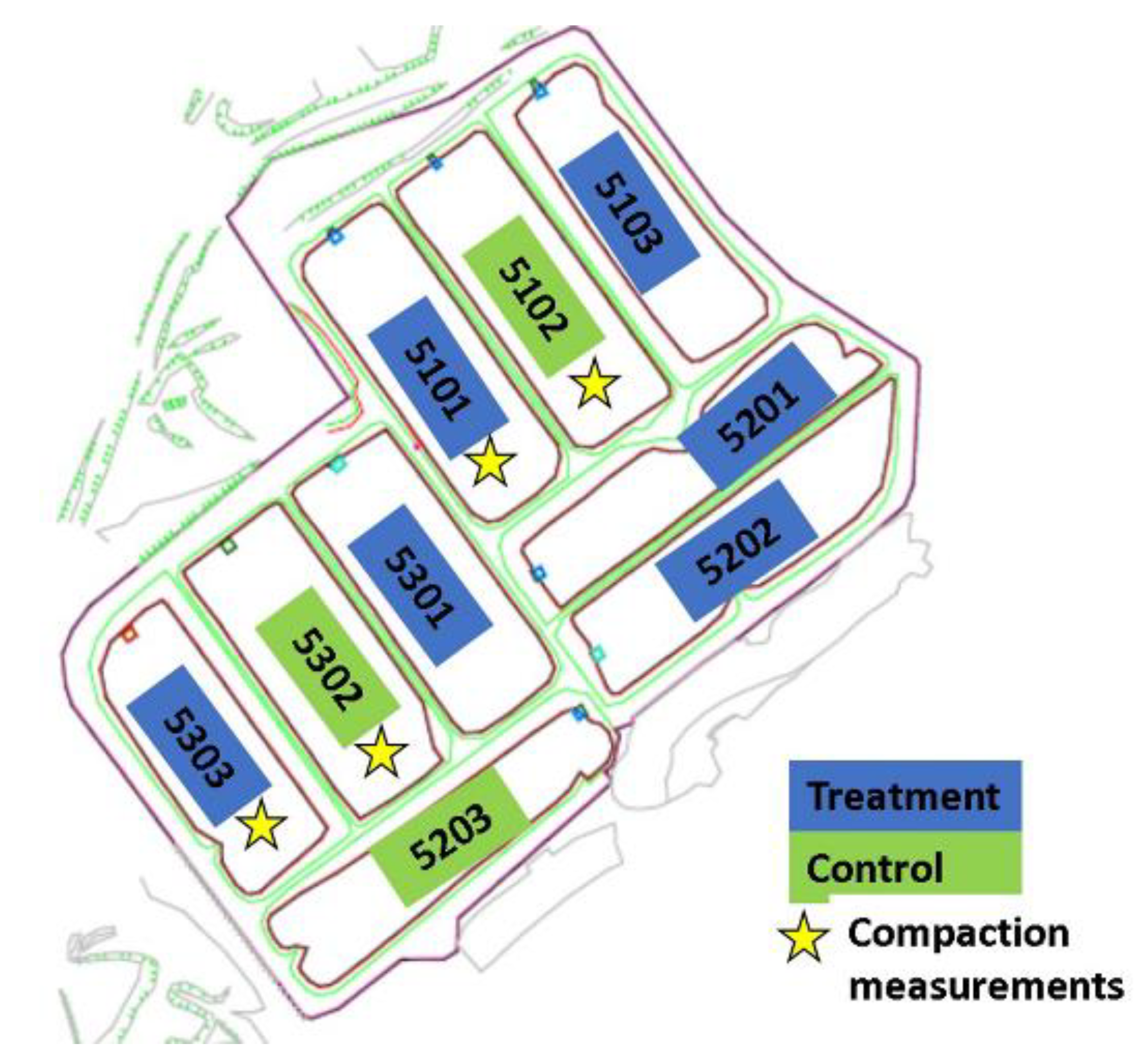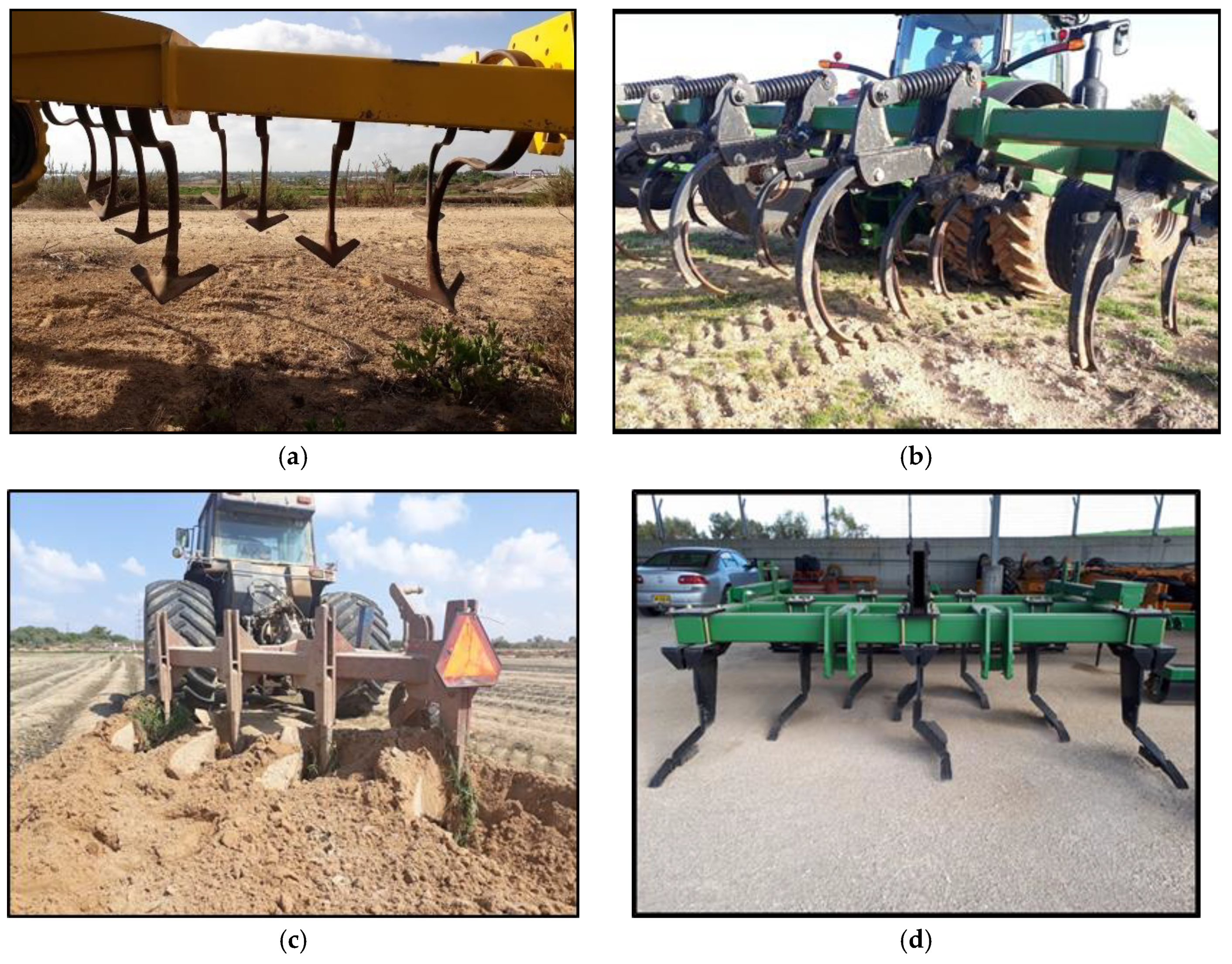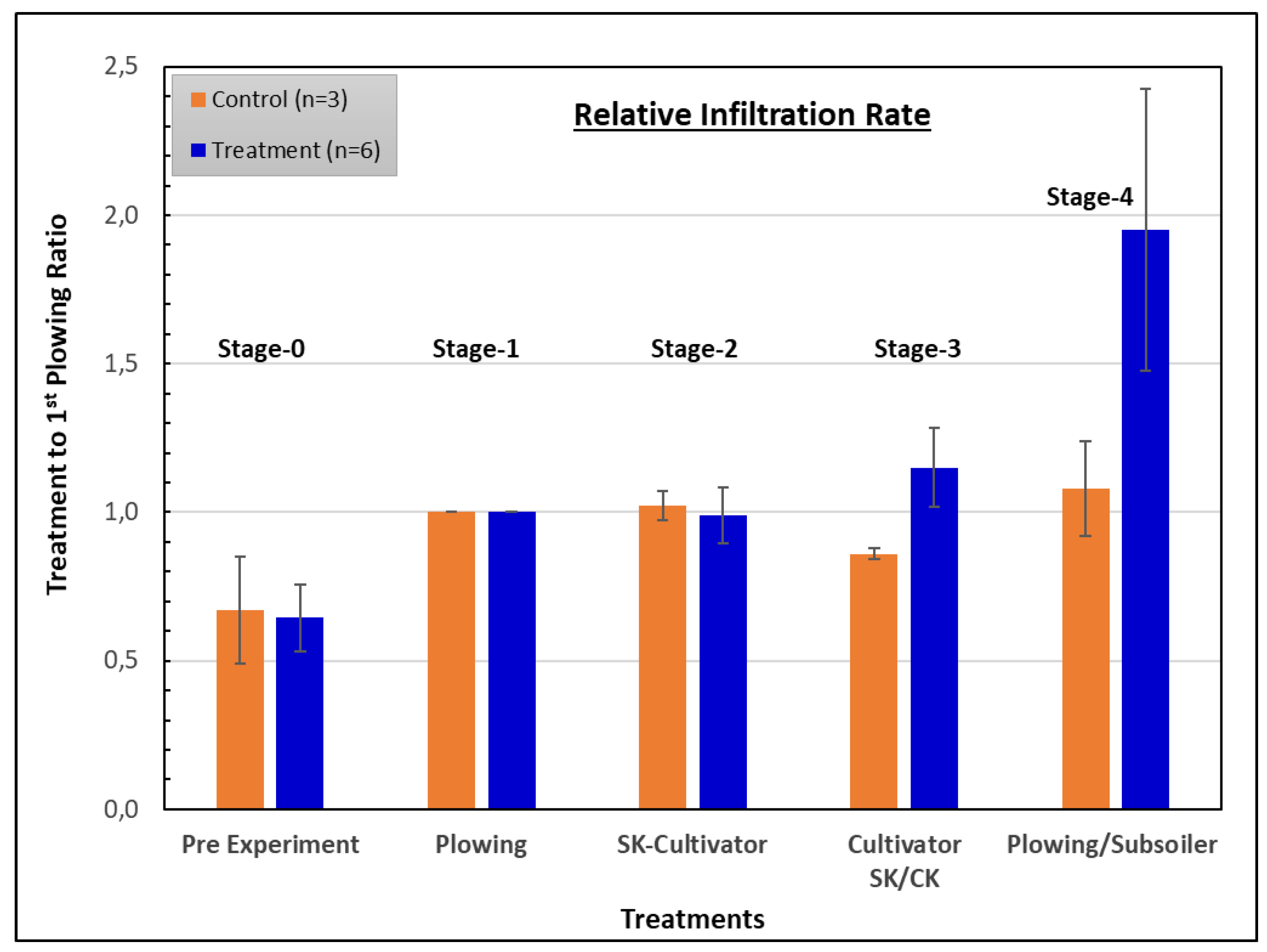The Effect of Soil Tillage Equipment on the Recharge Capacity of Infiltration Ponds
Abstract
1. Introduction
2. Materials and Methods
2.1. Research Outline
2.2. Tillage Equipment
2.3. Measurements and Analyses
3. Results
3.1. Infiltration Rates and Recharge Capacity
3.2. Soil Compaction
4. Discussion
5. Conclusions
- Complete drying (not draining!) of the soil before tillage operations: the basic rule is to prevent or minimize puddles, wet spots, or moist soil spots during the tillage process;
- Employing tillage equipment with the maximum possible width to minimize the number of passes on the pond;
- Employing tillage equipment that keeps the soil surface even, with minimum ridges and micro-topography effects; and
- Strict adherence to the correct recharge regime, and especially to the drying stage before flooding.
Author Contributions
Funding
Acknowledgments
Conflicts of Interest
Abbreviations
| SAT | Soil aquifer treatment |
| SK cultivator | Sweep knives cultivator |
| CK cultivator | Chisel knives cultivator |
| Mm3/year | Millions of cubic meters per year |
| IR | Infiltration rate |
| MAR | Managed aquifer recharge |
References
- Icekson-Tal, N.; Blanc, R. Wastewater Treatment and Groundwater Recharge for Reuse in Agriculture: Dan Region Reclamation Project, Shafdan. In Artificial Recharge of Groundwater; Peters, J.H., Ed.; August Aime Balkama: Rotterdam, The Netherlands, 1998; pp. 99–103. [Google Scholar]
- Lin, C.; Eshel, G.; Roehl, K.E.; Negev, I.; Greenwald, D.; Shachar, Y.; Banin, A. Studies of P Accumulation in Soil/Sediment Profiles Used for Large-Scale Wastewater Reclamation. Soil Use Manag. 2006, 22, 143–150. [Google Scholar] [CrossRef]
- Amy, G.; Drewes, J. Soil Aquifer Treatment (SAT) as a Natural and Sustainable Wastewater Reclamation/Reuse Technology: Fate of Wastewater Effluent Organic Matter (EfOM) and Trace Organic Compounds. Environ. Monit. Assess. 2007, 129, 19–26. [Google Scholar] [CrossRef] [PubMed]
- Lin, C.; Eshel, G.; Negev, I.; Banin, A. Long-Term Accumulation and Material Balance of Organic Matter in the Soil of an Effluent Infiltration Basin. Geoderma 2008, 148, 35–42. [Google Scholar] [CrossRef]
- Goren, O.; Burg, A.; Gavrieli, I.; Negev, I.; Guttman, J.; Kraitzer, T.; Kloppmann, W.; Lazar, B. Biogeochemical Processes in Infiltration Basins and Their Impact on The Recharging Effluent, The Soil Aquifer Treatment (SAT) System of The Shafdan Plant, Israel. Appl. Geochem. 2014, 48, 58–69. [Google Scholar] [CrossRef]
- Elkayam, R.; Michail, M.; Mienis, O.; Kraitzer, T.; Tal, N.; Lev, O. Soil Aquifer Treatment as Disinfection Unit. J. Environ. Eng. 2015, 141, 05015001. [Google Scholar] [CrossRef]
- Sopliniak, A.; Elkayam, R.; Lev, O. Quantification of dissolved organic matter in pore water of the vadose zone using a new ex-situ positive displacement extraction. Chem. Geol. 2017, 466, 263–273. [Google Scholar] [CrossRef]
- Elkayam, R.; Sopliniak, A.; Gasser, G.; Pankratov, I.; Lev, O. Oxidizer Demand in the Unsaturated Zone of a Surface-Spreading Soil Aquifer Treatment System. Vadose Zone J. 2015, 14. [Google Scholar] [CrossRef]
- Elkayam, R.; Aharoni, A.; Vaizel-Ohayon, D.; Sued, O.; Katz, Y.; Negev, I.; Marano, R.B.M.; Cytryn, E.; Shtrasler, L.; Lev, O. Viral and Microbial Pathogens, Indicator Microorganisms, Microbial Source Tracking Indicators, and Antibiotic Resistance Genes in a Confined Managed Effluent Recharge System. J. Environ. Eng. (United States) 2018, 144, 05017011. [Google Scholar] [CrossRef]
- Halperin, R. Halperin Committee Report, Principles for Granting Permits to Irrigate Effluents; Ministry of Health: Jerusalem, Israel, 2002. Available online: https://www.health.gov.il/hozer/bsv_Halperin.doc (accessed on 12 May 2019).
- Inbar, Y. The Ministry of Environmental Protection, ISRAEL. Available online: http://www.sviva.gov.il/InfoServices/ReservoirInfo/DocLib2/Publications/P0301-P0400/P0321.pdf (accessed on 12 May 2019).
- Elkayam, R. Shafdan Soil Aquifer Treatment System; Process Assessment & Improvement. Ph.D. Thesis, The Hebrew University of Jerusalem, Jerusalem, Israel, January 2019. [Google Scholar]
- Aharoni, A.; Negev, I.; Cohen, E.; Bar, O.; Bar-Noy, N.; Khadya, N. Monitoring Shafdan Effluents Recharge and the Third Line Project. In Analysis and Summary of Results: 2018 Yearly Report; Mekorot, National Water Co.: Tel Aviv-Yafo, Israel, 2019; (In Hebrew, abstract written In English). [Google Scholar]
- Aharoni, A.; Guttman, J.; Icekson-Tal, N.; Kraitzer, T.; Cikurel, H. SWITCH project Tel-Aviv Demo City, Mekorot’s case: Hybrid Natural and Membranal Processes to Up-Grade Effluent Quality. Rev. Environ. Sci. Biotechnol. 2010, 9, 193–198. [Google Scholar] [CrossRef]
- Pavelic, P.; Dillon, P.J.; Mucha, M.; Nakai, T.; Barry, K.E.; Bestland, E. Laboratory Assessment of Factors Affecting Soil Clogging Of Soil Aquifer Treatment Systems. Water Res. 2011, 45, 3153–3163. [Google Scholar] [CrossRef] [PubMed]
- Sharma, S.K.; Hussen, M.; Amy, G. Soil Aquifer Treatment Using Advanced Primary Effluent. Water Sci. Technol. 2011, 64, 640–646. [Google Scholar] [CrossRef] [PubMed]
- Rice, R.C.; Rice, C. Soil Clogging during Infiltration of Secondary Effluent. J. Water Pollut. Control Fed. 2013, 46, 708–716. [Google Scholar]
- Bouwer, H. Artificial recharge of groundwater: Hydrogeology and engineering. Hydrogeol. J. 2002, 10, 121–142. [Google Scholar] [CrossRef]
- Houston, S.L.; Duryea, P.D.; Hong, R. Infiltration Considerations for Ground-Water Recharge with Waste Effluent. J. Irrig. Drain. Eng. 1999, 125, 264–272. [Google Scholar] [CrossRef]
- Lin, C.; Greenwald, D.; Banin, A. Temperature Dependence of Infiltration Rate during Large Scale Water Recharge into Soils. Soil Sci. Soc. Am. J. 2003, 67, 487–493. [Google Scholar] [CrossRef]
- Nadav, I.; Tarchitzky, J.; Chen, Y. Soil cultivation for enhanced wastewater infiltration in soil aquifer treatment (SAT). J. Hydrol. 2012, 470–471, 75–81. [Google Scholar] [CrossRef]
- Mousavi, S.F.; Rezai, V. Evaluation of scraping treatments to restore initial infiltration capacity of three artificial recharge projects in central Iran. Hydrogeol. J. 1999, 7, 490–500. [Google Scholar] [CrossRef]
- Hamza, M.A.; Anderson, W.K. Soil compaction in cropping systems: A review of the nature, causes and possible solutions. Soil Tillage Res. 2005, 82, 121–145. [Google Scholar] [CrossRef]
- Batey, T. Soil compaction and soil management—A review. Soil Use Manag. 2009, 25, 335–345. [Google Scholar] [CrossRef]





| Stage | Dates | Tillage Treatment | Treatment Definition |
|---|---|---|---|
| Pre-treatment | 1–28 May 2018 | Plowing of all 9 ponds | (control) |
| Stage 1 | 28 May 2018–18 June 2018 | Plowing of all 9 ponds | Control |
| Stage 2 | 18 June 2018–9 July 2018 | SK 1 cultivator of all 9 ponds | Control |
| Stage 3 | 9 July 2018–6 August 2018 | 1. SK cultivator: 3 ponds | 1. Control |
| 2. CK 2 cultivator: 6 ponds | 2. Treatment | ||
| Stage 4 | 6 August 2018–3 September 2018 | 1. Plowing: 3 ponds | 1. Control |
| 2. Subsoiler: 6 ponds | 2. Treatment |
© 2020 by the authors. Licensee MDPI, Basel, Switzerland. This article is an open access article distributed under the terms and conditions of the Creative Commons Attribution (CC BY) license (http://creativecommons.org/licenses/by/4.0/).
Share and Cite
Negev, I.; Shechter, T.; Shtrasler, L.; Rozenbach, H.; Livne, A. The Effect of Soil Tillage Equipment on the Recharge Capacity of Infiltration Ponds. Water 2020, 12, 541. https://doi.org/10.3390/w12020541
Negev I, Shechter T, Shtrasler L, Rozenbach H, Livne A. The Effect of Soil Tillage Equipment on the Recharge Capacity of Infiltration Ponds. Water. 2020; 12(2):541. https://doi.org/10.3390/w12020541
Chicago/Turabian StyleNegev, Ido, Tamir Shechter, Lilach Shtrasler, Hadar Rozenbach, and Avri Livne. 2020. "The Effect of Soil Tillage Equipment on the Recharge Capacity of Infiltration Ponds" Water 12, no. 2: 541. https://doi.org/10.3390/w12020541
APA StyleNegev, I., Shechter, T., Shtrasler, L., Rozenbach, H., & Livne, A. (2020). The Effect of Soil Tillage Equipment on the Recharge Capacity of Infiltration Ponds. Water, 12(2), 541. https://doi.org/10.3390/w12020541




